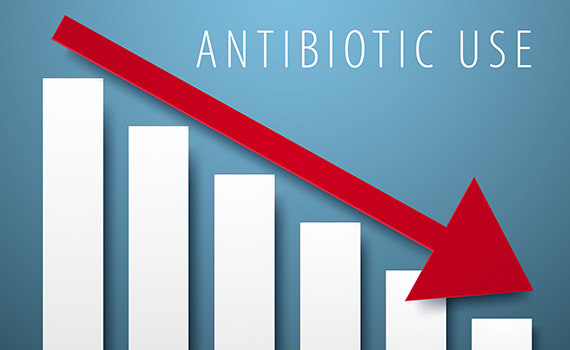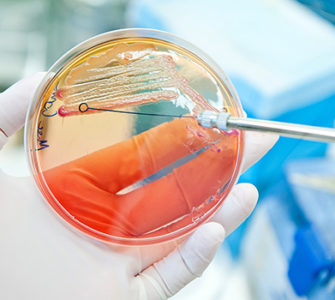E. coli vaccination reduces antibiotic use in broilers
New studies show that vaccination against Escherichia coli significantly reduced antibiotic use on commercial broiler farms, particularly in birds at high risk of infection.
E. coli infection — known as colibacillosis — is one of the most common and economically significant infectious diseases in poultry worldwide. In broilers, it is linked to inconsistent bird size and weights at processing, as well as increased condemnations due to cellulitis and airsacculitis.1
Pathogenic E. coli causes infection through exposure to contaminated feces, water and dust, so colibacillosis control in broilers typically relies on biosecurity and sanitation, with antibiotic treatment as needed. But as the poultry industry faces pressure to reduce antibiotic use, two large studies found that E. coli vaccination helped prevent infections that require antibiotic treatment.
44% reduction in number of antibiotic treatments
The studies, which were presented at the 2017 World Veterinary Poultry Association meeting in Edinburgh, assessed the impact of a commercially available, modified-live E. coli vaccine on antibiotic use in broilers. They were conducted by Zoetis in collaboration with independent veterinary practices in France and Germany.
The French study retrospectively evaluated a total of 3 million birds on 17 commercial broiler farms that had experienced regular outbreaks of E. coli infection. Approximately half the flocks received the E. coli vaccine according to label instructions, and the other half served as the unvaccinated control.2
Investigators found that E. coli vaccination resulted in a 44% reduction in the total number of antibiotic treatments (p = 0.0004), and a 40% reduction in antibiotic treatments specifically for colibacillosis (p = 0.03).
According to Charles Facon, DVM — one of the study’s authors and a veterinary consultant with Reseau Cristal — these findings are notable as poultry producers in France work to meet ambitious antibiotic-reduction targets.
“In France, we have a national plan to reduce antibiotic use by 25% in 5 years. As consumers grow more concerned about antimicrobial resistance, poultry companies are also putting pressure on producers to limit antibiotic use and develop alternatives,” he said.
“The results of our study confirm that E. coli vaccination is an effective tool for reducing the need for antibiotic treatment not just for colibacillosis but in general — particularly on farms that have high levels of disease challenge.
“In broiler production, 25% of the farms are responsible for 50% of total antibiotic exposure, so if we can limit the need for antibiotics on these farms, we can make a meaningful impact on antibiotic use overall.”
Lower treatment frequency
A separate study in Germany also revealed a link between E. coli vaccination and antibiotic reduction.3
Conducted in 3.3 million broilers on three different farms in different regions of the country, the study evaluated the effect of the same live E. coli vaccine on antibiotic-treatment frequency — a measure of average daily antibiotic use that is calculated with a special mathematical formula. As in the French study, the birds were divided between vaccine and control groups, but the German study also evaluated the effect of vaccinating the birds either on day 1 of life or between days 11 and 16.
Results indicate that E. coli vaccination meaningfully reduced antibiotic-treatment frequency, particularly when administered on day 1. However, the researchers noted that the appropriate timing of vaccination should be determined on a case-by-case basis, as use of the live, bacterial vaccine depends strongly on the health status of the day-old chicks.
According to study investigator Stephani Fischer, DVM — a veterinary consultant with Group Veterinary Practice WEK — these findings are significant because treatment frequency is the standard measure of antibiotic use in Germany and strictly regulated by the government.
“Producers in Germany are required to record antibiotic-treatment frequency. If they exceed regulated limits, they must file a lengthy report and develop a detailed antibiotic-reduction plan, which can be time-consuming, inconvenient and sometimes demoralizing for producers,” she explained.
“The most important part of any colibacillosis-control strategy is management. But in cases where management isn’t enough — such as on farms with older infrastructure or ones at high risk of disease — E. coli vaccination may help producers reduce antibiotic-treatment frequency, without compromising flock health and performance.”
1. http://www.poultryhub.org/health/disease/types-of-disease/colibacillosis/
2. Facon C, Galliard N, Turblin V, Marguerie J, Honore A, Delannoy A, Ledoux L. E. coli vaccination, a successful tool to reduce the use of antibiotics for colibacillosis treatment in broiler production. World Veterinary Poultry Association Conference. 2017, 297.
3. Fischer S, Weber R, Haverkamp C. Vaccination of broilers with a live Escherichia coli vaccine leads to a reduction of antibiotic treatments. World Veterinary Poultry Association. 2017, 288.
Posted on February 12, 2018
















